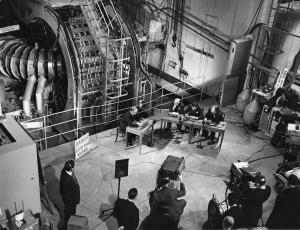The press conference at Harwell had been timed to coincide with the publication of a
Nature article, which also included results (although not as spectacular as Zeta's) from the Los Alamos Perhapstron and Columbus machines. Included in the coverage, but largely unnoticed by the general media, was a note by
Lyman Spitzer, the father of fusion research in the US.
Spitzer, an astrophysicist who had invented the concept of magnetic confinement and had built the first fusion machine in 1951, was highly skeptical of Zeta's results. There was a contradiction, he wrote, between the predictions of theory and the numbers reported, that suggested that "some unknown mechanism would appear to be involved." Fusion could not happen at 5 million degrees.
Others, like Lev Artsimovitch in Moscow, were more brutal in their refutation. As increasingly detailed analyses sowed more and more doubt, the Zeta triumph turned into an embarrassment.
Less than four months after the January 1958 news conference, "the H-men from Harwell"—as newspapers called the Zeta team—had to issue a corrective news release, acknowledging that the neutrons they had observed had nothing to do with the fusion of deuterium nuclei, but rather owed their existence to complex phenomena originating in plasma instabilities.
The Zeta affair dealt a severe blow to the credibility of fusion research; too many expectations and too much excitement had resulted in a huge disappointment. But there were precious lessons to be learned. One of the most important was that fusion research was doomed if it was to be pursued in the secrecy of national laboratories. Peer review, the sharing of information and doubts, and a common analysis of failures or potential successes were essential not only to the credibility of fusion research but also to its success.
One month later in Geneva, the "Second United Nations International Conference on the Peaceful Uses of Atomic Energy" (
Atoms for Peace) opened the door to such collaboration. And ten years later at the
Novosibirsk fusion conference, when Lev Artsimovitch presented the exceptional results obtained in the soviet T-3 and TM-3 tokamaks (a 20-millisecond plasma at a temperature of 10 million degrees) it was a British team that was invited to
do the checking and that eventually confirmed the breakthrough.
As for Zeta—for some time, the largest fusion machine in operation—it went on to have a very productive career in plasma studies. But its species belonged to an evolutionary dead end. By the late 1960s the time of the tokamak had come.



